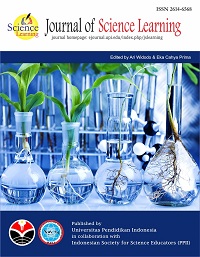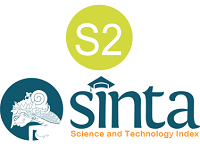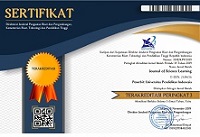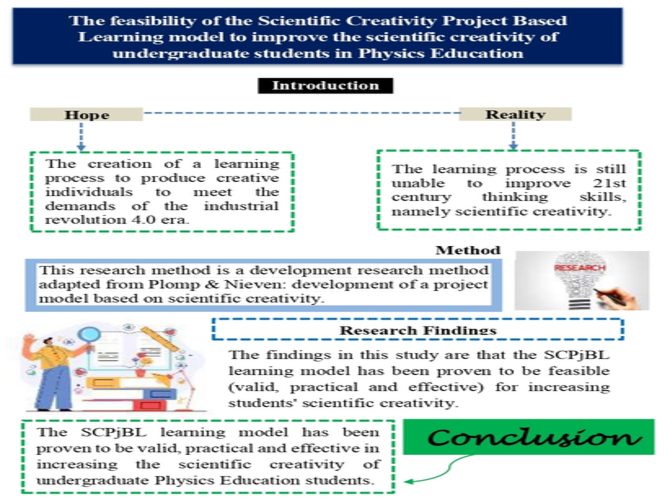
Fostering Scientific Creativity Through Feasibility Project-Based Learning in Undergraduate Physics
Abstract
Education plays a crucial role in building human resources. In the 21st century, a person is required to master four skills, one of which is creativity, as a response to the increasingly rapid development of technology towards a society 5.0. The development of a PjBL model combined with scientific creativity represents the innovation in this research. This study aims to enhance students' scientific creativity in introductory Physics 1 courses through a scientifically creative project-based learning model, which has been further developed and evaluated for its validity, practicality, and effectiveness. This research method is a developmental research process that comprises four phases: preliminary, development, validation, and implementation. The sample for this study consisted of 175 students. The practicality and efficacy of this study are assessed using student response questionnaires, test instruments, and implementation observation guidelines. Research findings: 1) validity, the validity results show that the research tools are valid and reliable; 2) practical, well implemented, and can be used for the learning process; 3) effective, can significantly improve the scientific creativity of undergraduate students at α = 5%, The typical n-Gain of learners falls within the high range, and the feedback from students regarding the learning experience is highly favorable. This study concludes that the SCPjBL model is an effective method for enhancing the scientific creativity of college students enrolled in introductory physics classes.
Keywords
Full Text:
Download PDFReferences
Admoko, S., Sari, E. P. D. N., & Hariyono, E. (2023). Online discussion in improving argumentation skills during last decade: A review. International Journal of Evaluation and Research in Education, 12(4), 1880-1892.
Aero, A. (2023). Teaching for how students learn : A model of learning and teaching. In Australian Education Research Organisation (Issue September, p. 2).
Akker, J. J. H., Plomp, T., Bannan, B., Cobb, P., Folmer, E., Gravemeijer, K. P. E., ... & Nieveen, N. M. (2013). Educational design research. SLO.
Al-Kamzari, F., & Alias, N. (2025). A systematic literature review of project-based learning in secondary school physics: theoretical foundations, design principles, and implementation strategies. Humanities and Social Sciences Communications, 12(1), 1–18. https://doi.org/10.1057/s41599-025-04579-4
Altiparmak, T., & Eryilmaz-Muştu, Ö. (2021). The Effects of SCAMPER Technique Activities in the 8th Grade Simple Machines Unit on Students’ Academic Achievement, Motivation and Attitude towards Science Lessons*. International Journal of Educational Methodology, 7(1), 155–170. https://doi.org/10.12973/ijem.7.1.155
Ananda, L. R., Rahmawati, Y., & Khairi, F. (2023). Critical Thinking Skills of Chemistry Students by Integrating Design Thinking with STEAM-PjBL. Journal of Technology and Science Education, 13(1), 352-367.
Andres, E. C. A., & Rosalinda, B. (2023). Online Flipped Learning Model in a College Physical Education Course. European Journal of Educational Research, 13(1), 413–425.
Arends, R. (2008). Learning to teach. McGraw-Hill Humanities/Social Sciences/Languages.
Ariandani, N., Ermanda, S., & Fajri, N. (2020). The Effect of Project-Based Learning Model Using Three Dimensional Media and Computation on Achievement of Study Reviewed based of Student’s Creativity. Journal of Physics: Conference Series, 1539(1). https://doi.org/10.1088/1742-6596/1539/1/012056
Arzak, K. A., & Prahani, B. K. (2023). Practicality of Augmented Reality Books in Physics Learning: A Literature Review. JPPS (Jurnal Penelitian Pendidikan Sains), 12(2), 138–154. https://doi.org/10.26740/jpps.v12n2.p138-154
Astutik, S., & Prahani, B. K. (2018). The practicality and effectiveness of Collaborative Creativity Learning (CCL) model by using PhET simulation to increase students’ scientific creativity. International Journal of Instruction, 11(4), 409–424. https://doi.org/10.12973/iji.2018.11426a
Ayas, M. B., & Sak, U. (2018). Objective Measure of Scientific Creativity : Psychometric Validity of the Creative Scientific Ability Test Objective measure of scientific creativity : Psychometric validity of the Creative Scientific Ability Test. Thinking Skills and Creativity, 13(October), 195–205. https://doi.org/10.1016/j.tsc.2014.06.001
Blackmore, C., Vitali, J., Ainscough, L., Langfield, T., & Colthorpe, K. (2021). A Review of Self-Regulated Learning and Self-Efficacy: The Key to Tertiary Transition in Science, Technology, Engineering and Mathematics (STEM). International Journal of Higher Education, 10(3), 169-177.
Borich, G. D. (1974). An Evaluation of the Personalized Model of Teacher Training. Final Report.
Boss, S. (2011). Project-based learning: A short history. Edutopia.
Cirkony, C. (2023). Flexible, creative, constructive, and collaborative: the makings of an authentic science inquiry task. International Journal of Science Education, 45(17), 1440–1462. https://doi.org/10.1080/09500693.2023.2213384
Clark, R. M., Kaw, A., & Guldiken, R. (2023). Metacognition instruction and repeated reflection in a fluid mechanics course: Reflective themes and student outcomes. International Journal of Mechanical Engineering Education, 51(4), 243-269.
Coulter, X. (2020). The lure of autocratic education in a somewhat democratic society. Athens Journal of Education, 7(4), 331–352. https://doi.org/10.30958/aje.7-4-1
Creswell, J. W. (2018). Research Design: Qualitative, Quantitative and Mixed Methods Approaches. SAGE.
Dolmans, D. H. (2019). How theory and design-based research can mature PBL practice and research. Advances in health sciences education, 24(5), 879-891.
Dwikoranto, Jatmiko, B., Hariyono, E., Lestari, N. A., Prahani, B. K., & Suyidno. (2021). MobLen Model for Enhancing Scientific Creativity of Physics Students: An Alternative in the Covid-19 Pandemic. Journal of Physics: Conference Series, 1805(1). https://doi.org/10.1088/1742-6596/1805/1/012006
Georgiou, H., Turney, A., Matruglio, E., Jones, P., Gardiner, P., & Edwards-groves, C. (2022). Creativity in Higher Education : A Qualitative Analysis of Experts Views in Three Disciplines. Education Sciences MDPI, 12(154). https://doi.org/https://doi.org/10.3390/educsci12030154
Guasch, B., González, M., & Cortiñas, S. (2020). Educational toolkit based on design methodologies to promote scientific knowledge transfer in secondary schools: A graphene-centered case study. Journal of Technology and Science Education, 10(1), 17–31. https://doi.org/10.3926/jotse.787
Hake, R. R. (1998). Interactive-engagement versus traditional methods: A six-thousand-student survey of mechanics test data for introductory physics courses. American Journal of Physics, 66(1), 64–74. https://doi.org/10.1119/1.18809
Hinton, P. R., McMurray, I., & Brownlow, C. (2014). SPSS explained. Routledge.
Hu, W., & Adey, P. (2002). A scientific creativity test for secondary school Students. Research Report, 24(4), 389–403. https://doi.org/10.1080/09500690110098912
Hu, W., & Adey, P. (2010). A scientific creativity test for secondary school students. International Journal of Science Education, 24(4), 389–403. https://doi.org/10.1080/09500690110098912
Hu, Y. (2024). The Implementation of Project-Based Learning in Chinese Basic Education: Challenges and Recommendations. Science Insights Education Frontiers, 21(1), 3363–3374. https://doi.org/10.15354/sief.24.re349
Kartika, S., Saepuzaman, D., Rusnayati, H., Karim, S., & Feranie, S. A. (2019). The influence of scientific creativity and critical worksheet (SCCW) on project based learning to increase cognitive ability, scientific creative skills and scientific critical skills senior high school students on sound wave problem. Journal of Physics: Conference Series, 1280(5). https://doi.org/10.1088/1742-6596/1280/5/052002
Khoiri, N., Ristanto, S., & Kurniawan, A. F. (2023). Project-Based Learning Via Traditional Game in Physics Learning: Its Impact on Critical Thinking, Creative Thinking, and Collaborative Skills. Jurnal Pendidikan IPA Indonesia, 12(2), 286–292. https://doi.org/10.15294/jpii.v12i2.43198
Koç, A., & Büyük, U. (2021). Effect of Robotics Technology in Science Education on Scientific Creativity and Attitude Development. In Journal of Turkish Science Education (Vol. 18, Issue 1, pp. 54–72). https://doi.org/10.36681/tused.2021.52
Lucas, G. (2005). Instructional Module Project Based Learning. Educational Foundation, 3.
Moreno, R. (2010). Educational psychology. John Wiley & Sons, Inc.
Mukhopadhyay, R., & Sen, M. K. (2013). Scientific creativity-A new emerging field of research: Some considerations. International Journal of Education and Psychological Research, 2(1), 1-9.
Nur, M., Yuanita, L., Prahani, B. K., & Jatmiko, B. (2018). Effectiveness of Creative Responsibility Based Teaching (CRBT) Model on Basic Physics Learning to Increase Student's Scientific Creativity and Responsibility. Journal of Baltic Science Education, 17(1), 136-151.
Oktavia, R., Mirza, A. A., & Qamariah, Z. (2023). The history of curriculum in Indonesia: a literature study. PUSTAKA: Jurnal Bahasa dan Pendidikan, 3(4), 105-117.
Ong, E. T., Govindasamy, D., Singh, C. K. S., Ibrahim, M. N., Wahab, N. A., Borhan, M. T., & Tho, S. W. (2021). The 5E inquiry learning model: Its effect on the learning of electricity among Malaysian students. Cakrawala Pendidikan, 40(1), 170–182. https://doi.org/10.21831/cp.v40i1.33415
Özreçberoğlu, N., & Çağanağa, Ç. K. (2018). Making it count: Strategies for improving problem-solving skills in mathematics for students and teachers’ classroom management. Eurasia Journal of Mathematics, Science and Technology Education, 14(4), 1253–1261. https://doi.org/10.29333/ejmste/82536
Pariona, D., & López, R. (2023). Formative research and the achievement of skills based on undergraduate theses in university higher education. Journal of Technology and Science Education, 13(2), 498–513. https://doi.org/https://doi.org/10.3926/jotse.1744
PISA. (2023). Results Factsheets Indonesia.‖. The Language of Science Education, 1(2023), 1-9.
Plomp, T., & Nieveen, N. M. (2010). An introduction to educational design research: Proceedings of the seminar conducted at the East China Normal University, Shanghai (PR China), November 23-26, 2007. Stichting Leerplan Ontwikkeling (SLO).
Pont-Niclòs, I., Martín-Ezpeleta, A., & Echegoyen-Sanz, Y. (2023). the Turning Point: Scientific Creativity Assessment and Its Relationship With Other Creative Domains in First Year Secondary Students. Jurnal Pendidikan IPA Indonesia, 12(2), 221–231. https://doi.org/10.15294/jpii.v12i2.42835
Prahani, B. K. (2023). The dHOTLearn Model to Improve Critical Thinking Skills of Physics Education Program Undergraduate. Journal of Higher Education Theory and Practice, 23(19), 113–124. https://doi.org/10.33423/jhetp.v23i19.6676
Putri, S. U., Sumiati, T., & Larasati, I. (2019, February). Improving creative thinking skill through project-based-learning in science for primary school. In Journal of Physics: Conference Series (Vol. 1157, No. 2, p. 022052). IOP Publishing.
Rahayu, R., Iskandar, S., & Abidin, Y. (2022). Inovasi Pembelajaran Abad 21 dan Penerapannya di Indonesia [21st Century Learning Innovations and Their Implementation in Indonesia]. Jurnal Basicedu, 6(2), 2099–2104. https://doi.org/10.31004/basicedu.v6i2.2082
Rusmini, R., Suyono, S., & Agustini, R. (2021). Analysis of science process skills of chemical education students through self project based learning (SjBL) in the pandemic COVID 19 era. JOTSE, 11(2), 371-387.
Saepudin, A. (2020). Project Based Learning Implementation to Student's Scientific Attitude and Creativity Improvement. Jurnal Mangifera Edu, 5(1), 64-77.
Santrock, J. W. (2015). Life-span development (p. 800). New York: McGraw-Hill.
Santyasa, I. W., Rapi, N. K., & Sara, I. (2020). Project based learning and academic procrastination of students in learning physics. International Journal of instruction, 13(1), 489-508.
Schaffar, B., & Wolff, L. A. (2024). Phenomenon-based learning in Finland: a critical overview of its historical and philosophical roots . Cogent Education, 11(1). https://doi.org/10.1080/2331186X.2024.2309733
Setemen, K., Sudirtha, I. G., & Widiana, I. W. (2023). The effectiveness of study, explore, implement, evaluate model e-learning based on project-based learning on the conceptual understanding and agility of students. JOTSE, 13(3), 583-596.
Sevilla, C. G., Ochave, J. A., Punsalan, T. G., Regala, B. P., & Uriarte, G. G. (1984). An introduction to research methods. Rex Book Store.
Shofiyah, N., Jatmiko, B., Suprapto, N., & Kurnia, B. (2025). Social Sciences & Humanities Open The use of technology to scientific reasoning in science education : A bibliometric and content analysis of research papers. Social Sciences & Humanities Open, 11(April), 101534. https://doi.org/10.1016/j.ssaho.2025.101534
Sidek, R., Halim, L., Buang, N. A., & Mohamad Arsad, N. (2020). Fostering Scientific Creativity in Teaching and Learning Science in Schools: A Systematic Review. Jurnal Penelitian Dan Pembelajaran IPA, 6(1), 13. https://doi.org/10.30870/jppi.v6i1.7149
Siew, N. M., & Ambo, N. (2020). The Scientific Creativity Of Fifth Graders In A Stem Project-Based Cooperative Learning Approach. Journal of Problems of Education In The 21st Century, 78(4), 1–36. https://doi.org/https://doi.org/10.33225/pec/20.78.627
Slavin, R. E. (2016). Instruction based on cooperative learning: Handbook of research on learning and instruction. Taylor & Francis.
Sugiyono. (2018). Metode penelitian pendidikan pendekatan kuantitatif, kualitatif dan R&D [Educational research methods quantitative, qualitative and R&D approaches]. Alfabeta.
Sukamto, T. (2022). Pemanfaatan Media Phet Simulation Pada Pembelajaran Fisika Dengan Pendekatan Contextual Teaching and Learning [Utilization of Phet Simulation Media in Physics Learning with Contextual Teaching and Learning Approach]. Jurnal Educatio, 8(2), 649–654. https://doi.org/10.31949/educatio.v8i2.2327
Sulisworo, D. (2020, October). The Improvement of Higher-Order Thinking Skills Through Project-Based Learning on STEM Education Settings. In International Conference on Community Development (ICCD 2020) (pp. 504-507). Atlantis Press.
Sumo, M., Jatmiko, B., Arifin, Z., & Supardi, I. (2024a). Profile of Scientific Creativity Based on Project Based Learning of Physics Education Undergraduate Students : Preliminary research. Jurnal Ilmu Pendidikan Fisika (JIPF), 9(3), 377–386. https://doi.org/10.26737/jipf.v9i3.5802
Sumo, M., Jatmiko, B., Arifin, Z., Supardi, I., & Sueharto, S. (2024b). Validity And Practicality of The Scientific Creativity Project-Based Learning (SCPjBL) Model to Increase The Scientific Creativity of Physics Education Undergraduate Students. IJORER: International Journal of Recent Educational Research, 5(6), 1353-1366.
Suyidno, M., Dewantara, D., Nur, M., & Yuanita, L. (2017, May). Maximizing Students' Scientific Process Skill within Creative Product Design: Creative Responsibility Based Learning. In 5th SEA-DR (South East Asia Development Research) International Conference 2017 (SEADRIC 2017) (pp. 98-103). Atlantis Press.
Suyidno, S., Susilowati, E., Arifuddin, M., Sunarti, T., Siswanto, J., & Rohman, A. (2020). Barriers to Scientific Creativity of Physics Teacher in Practicing Creative Product Design. Journal of Physics: Conference Series, 1491(1). https://doi.org/10.1088/1742-6596/1491/1/012048
Tadros, J. R., Cunha, S., Waehneldt, A. B. D. A., Cirilo, J. C., Gonçalves, K., Barbosa, C., Amaral, S., Waehneldt, A. B. D. A., Henrique, A., Paula, B. De, Gatti, B. A., Weinberg, P. D., & Mcnamara, A. (2019). Project-based learning in german vocational education and training: A structured approach to developing self-determined, cooperative problem-solving competence. Senac Journal of Education and Work, 44(3).
Torrance, E. P. (1965). Scientific views of creativity and factors affecting its growth. Daedalus, 663-681.
Van den Akker, J., Bannan, B., Kelly, A. E., Nieveen, N., & Plomp, T. (2013). Educational design research part (A): An introduction. Enschede: Enschede, the Netherlands: Netherlands Institute for Curriculum Development (SLO).
Wainwright, M. (2018). The Strengths and Weaknesses of Ramism. The Rational Shakespeare, 4(3), 79–104. https://doi.org/10.1007/978-3-319-95258-1_5
Wibowo, F. C. (2023). Effects of Augmented Reality Integration (ARI) Based Model Physics Independent Learning (MPIL) for Facilitating 21st-Century Skills (21-CS). Journal of Technology and Science Education, 13(1), 178-192.
Zulkarnaen, Z., Supardi, Z. A. I., & Jatmiko, B. (2017). Feasibility of Creative Exploration, Creative Elaboration, Creative Modeling, Practice Scientific Creativity, Discussion, Reflection (C3PDR) Teaching Model to Improve Students’ Scientific Creativity of Junior High School. Journal of Baltic Science Education, 16(6), 1020-1034.
DOI: https://doi.org/10.17509/jsl.v8i2.83225
Refbacks
- There are currently no refbacks.
Copyright (c) 2025 Maimon Sumo, Soeharto Soeharto

This work is licensed under a Creative Commons Attribution-ShareAlike 4.0 International License.
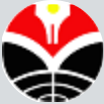

Jl. Dr. Setiabudhi 229 Bandung 40154, West Java, Indonesia





